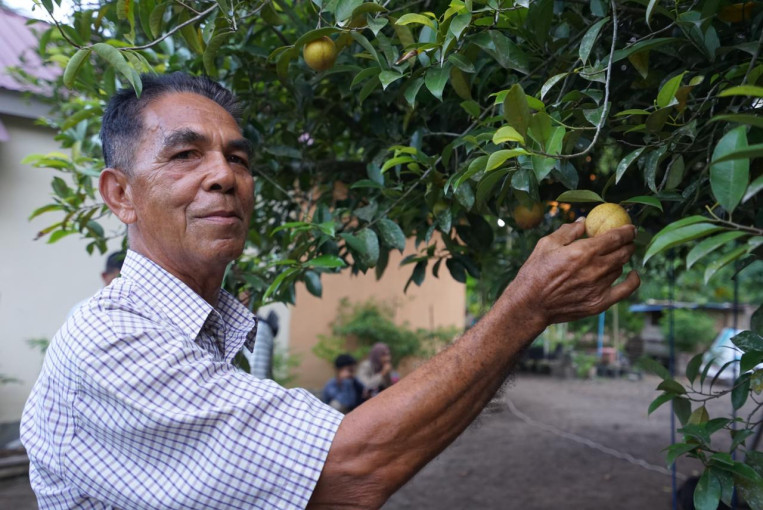
North Maluku is known as a producer of nutmeg and cloves. It is rightfully referred to as the “Spice Island” because it is Indonesia’s top producer of spices.
Efforts to revive the glory of spices in North Maluku as a world cultural heritage are part of UGM’s flagship research. With the North Halmahera Government, UGM is working on developing the North Maluku spice cosmopolis.
Director of Research at UGM, Professor Mirwan Ushada, stated that UGM manages flagship research to advance science and technology. Research is integrated and concentrated on the creation of cutting-edge technology for the prosperity and sovereignty of Indonesia.
One of these initiatives involves developing a spice cosmopolis.
“North Maluku is an iconic province of spices. UGM aims to develop a North Maluku cosmopolis, a term we propose to complement what is known as the spice route,” he explained while conducting spice mapping in North Halmahera.
Research related to spice cosmopolis has been conducted since 2021, with the formation involving faculty members and researchers from various fields, including history, medicine, forestry, archaeology, and more.
More than 20 researchers will study various areas to revive the glory of spices in North Maluku. The approach involves reconstruction, revitalization, and innovation.
Professor Ushada explained that reconstruction entails uncovering North Maluku’s local values and culture. Subsequently, revitalization will be carried out to rekindle the glory of spices.
The results of UGM’s recent Student Community Service (KKN) in North Halmahera will serve as initial information for research.
Through this approach, a study will be conducted to bridge the gap between past and present glory, leading to innovation that meets present-day needs.
He stated there’s significant potential for collaboration between UGM and North Halmahera in realizing North Maluku Cosmopolis.
Some opportunities include exploring spice plants through biodiversity identification, economic potential assessment, cultural heritage documentation for uncovering local potential, the development of the Teluk Kao living museum, community empowerment for economic strengthening, food security, local culture supporting spice cosmopolis, and integrating support for tourism master plan development.
UGM’s research collaboration with the North Halmahera Government aligns with sustainable development goals, including partnerships to achieve those goals and reduce hunger and poverty (SDG 1, 2, and 17).
The Secretary of North Halmahera, Erasmus J. Papilaya, mentioned that nutmeg is a leading commodity in his region, especially Dukono nutmeg, which is larger than other types. This nutmeg has been certified by the Indonesian Ministry of Agriculture.
Responding to UGM’s collaborative invitation for research on spice development, Papilaya welcomed the initiative.
Nutmeg cultivation requires collaboration with various parties since North Halmahera’s people have yet to optimize nutmeg utilization fully. Thus, it is expected that nutmeg development can enhance the welfare of residents and regional income.
Nutmeg remains a vital source of livelihood for many residents in North Maluku. One such individual is Jainudin Kambosa, a resident of Ngidiho Village in West Galela District, North Halmahera Regency, North Maluku Province.
He relies on nutmeg cultivation for his livelihood. He earns a minimum of Rp500,000 from nutmeg harvests weekly.
“We have about 50 nutmeg trees in our garden. We usually harvest weekly, but the yield varies depending on weather conditions. Whether it’s enough or not, we’re grateful for it to cover our children’s school expenses,” he said.
Additionally, Theo Djiko, a Pitu Village, Central Tobelo District, North Halmahera resident, manages a nutmeg garden inherited from his parents after retiring.
“My father planted the nutmeg trees, and they might be around 28 years old,” he said.
Unlike most residents who harvest nutmeg weekly, Djiko does it daily by collecting fallen fruit. Every day, go-betweens collect the harvest. Nutmeg seeds are sold at Rp85,000 per kg, while mace is sold at Rp200,000 per kg.
“Mace is the most valuable part. Meanwhile, the fruit flesh is discarded,” he explained.
According to data from the North Halmahera Government, in 2023, there were 9,127 nutmeg farmers in North Halmahera.
The highest number of nutmeg farmers is in West Galela District, totaling 1,518 individuals, followed by Malifut District with 973 nutmeg farmers, North Kao District with 767, and West Tobelo District with 704 farmers.
Head of Ngidiho Village Kamal Abdullah stated that his village initiated a nutmeg tree planting program for residents before 2003.
The program required each household to plant at least 50 nutmeg trees, resulting in now around 400 families having nutmeg trees.
In the archipelago’s history, North Maluku, particularly Ternate and Tidore, was a well-known spice trading route in the 15th century.
Dr. Sri Margana, a UGM researcher of Spice Cosmopolis, explained that the spice trade in Maluku began with Chinese merchants who introduced spices to people in the Mediterranean region.
This sparked the arrival of European traders to North Maluku, who purchased spices directly from the locals.
Dr. Margana stated that spices were more valuable than gold, becoming a sought-after commodity for the Europeans.
Beyond satisfying their palates and lifestyles, spices symbolized their social status and nobility during that era. Spices on the dining table were used to display their social standing and nobility.
“The potential for spices in North Maluku is substantial, although it’s not the same as before,” he explained.
He pointed out that the cultivation of spices, including nutmeg, in North Maluku has changed. Nutmeg was once grown by large corporations. Nowadays, individual members of the community can do nutmeg farming.
“Contrary to the past, businesses no longer cultivate spices in Maluku. There is no replanting; people only manage the inherited fields,” he said.
For this reason, UGM’s Spice Cosmopolis team aims to map out nutmeg cultivation, including the cultivation areas, volume, cultivators, and marketing.
This effort seeks to provide a roadmap for the spice cosmopolis program, particularly for the revitalization program in North Maluku.
Author/Photographer: Ika

